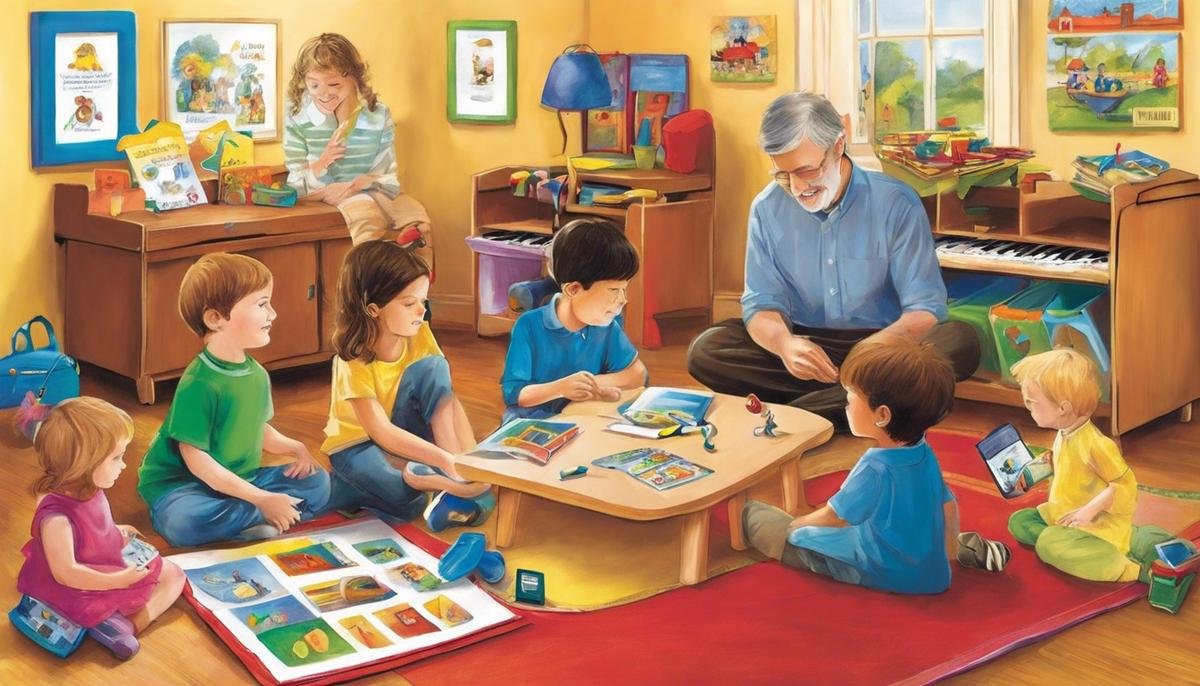
The intricate world of autism spectrum disorder presents unique challenges, not least of which is the occurence of physical aggression in some individuals. Understanding the roots of such behavior is essential in developing an empathetic and effective approach to support those with autism. This firmament of comprehension is vital for caregivers, educators, and the general public, as it sheds light on how sensory overstimulation, communication difficulties, and the pursuit of environmental control can drive a child to express stress or frustration through physical means. With the right educational tools and strategies, we can aspire to create environments that not only mitigate these aggressive behaviors but also foster positive growth and development for individuals with autism.
Understanding the Roots of Aggression in Autism
Understanding Aggressive Behaviors in Children with Autism
As any nurturing home-maker or devoted keeper of family wisdom knows, each child is a unique kaleidoscope of behaviors, needs, and expressions of emotion. Within the rich tapestry of family life, children with autism are often beautiful enigmas, showing us the world through a different lens. One puzzle piece that families sometimes encounter is understanding and addressing aggressive behaviors in children with autism.
For starters, it’s critical to remember that aggression in children with autism can be caused by a variety of factors, and it’s not a reflection of parenting skills. Many parents face this challenge, so you’re not alone here in this vibrant community of caretakers.
One key factor to consider is communication difficulties. Children with autism may struggle with verbalizing their thoughts and feelings. When words fail them, frustration can accumulate like a high-pressure weather system and aggressive behaviors can be the thunderclap that breaks the silence. It’s their way of saying, “Hey, I’m here, and something’s not right!“
Sensory overload is another significant contributor. Imagine a world where the hum of a refrigerator sounds like a freight train or the touch of a cotton shirt feels like sandpaper. This is the everyday reality for some children with autism who have heightened sensory sensitivities. When the sensory input becomes too intense, aggression may occur as a reflexive defense against the overwhelming stimuli.
Another point to consider is that routines heavily anchor children with autism. Disruptions in these routines can shake their sense of order and predictability, leaving them feeling unsettled and prone to lash out. It’s their way of coping with the unexpected changes thrown their way.
Don’t forget, anxiety and other emotional stressors can also play a large role in spurts of aggression. It’s like carrying a backpack that’s too heavy; eventually, the weight becomes too much, and the need to drop it becomes urgent and explosive.
In understanding these behaviors, the toolbox for management opens up. Consistent communication strategies, creating a sensory-friendly environment, maintaining routines, and fostering coping mechanisms for anxiety can work wonders. Each of these tools not just limits aggressive behavior but also enriches the child’s relationship with the world around them.
So, dear nurturing souls and wise architects of household bliss, remember, every aggressive behavior has a root that, when understood, can transform challenges into blossoming opportunities for growth and connection. As part of this sharing, learning, and ever-growing community, you’re capable of guiding those precious ones to calmer waters, one understanding moment at a time.

Behavioral Strategies and Interventions
Creating a Positive Environment to Manage Aggression in Autistic Children
Building a harmonious and supportive family dynamic often means navigating the hills and valleys of behavioral challenges. When caring for a child with autism who exhibits aggressive behaviors, the way forward involves patience, understanding, and thoughtful strategies. These strategies are not just about curbing aggression; they’re about cultivating a nurturing environment where every family member can thrive.
One effective approach is to establish a clear and consistent system of rewards and sanctions. This method hinges on recognizing and praising positive behaviors while also setting firm and predictable consequences for aggression. It’s all about balance and consistency. By acknowledging good behavior with plenty of encouragement, a child is likely to repeat those behaviors. And when boundaries are crossed, calm but firm consequences remind the child of the behavior that’s expected in a loving yet structured way.
Behavioral strategies also involve helping a child with autism understand their own triggers and how to handle them. This can involve teaching them to identify the warning signs of frustration or anger and providing them with coping mechanisms or diversion tactics. It could be as simple as squeezing a stress ball, taking deep breaths, or finding a quiet space in the home to decompress. Equipping a child with these personal tools can empower them to take control of their feelings before they escalate.
Another key strategy is to engage in perspective-taking activities, showing empathy and helping a child to do the same. Since children with autism can struggle with understanding others’ emotions, practicing scenarios and role-playing can nurture empathy and, in turn, reduce instances of aggressive behavior born from misunderstanding.
Structured environments are a cornerstone for reducing anxiety and confusion, but flexibility should also be fostered. Gradually introducing small changes can help a child with autism adapt to new situations without becoming overwhelmed. This gentle push towards flexibility can help prepare them for the unpredictable nature of life outside the comfort of routine.
When applying these strategies, it’s crucial to also engage in self-care and seek support when needed. Caring for a child with autism can be a demanding task, and maintaining one’s well-being is fundamental to being the best caregiver possible. Connecting with other parents, family support groups, or professionals can provide valuable insights and create a network of understanding and solidarity.
Above all, remember this journey with an autistic child is filled with learning and love. By employing these behavioral strategies, the goal is not only to manage aggression but also to enhance communication, foster emotional growth, and celebrate every milestone together. As the bond within the family strengthens, so too does the ability for each member, especially an autistic child, to navigate the world with confidence and grace.
Because in the end, isn’t that what every parent aspires for their child? The strength to face challenges, the ability to express themselves, and the warmth of knowing their family understands and supports them every step of the way.

The Importance of Consistent Routines
Delving deeper into the ways consistent routines benefit autistic children with aggressive tendencies, one can appreciate how structure brings a sense of security to their world.
Predictability can significantly reduce episodes of aggression by minimizing the uncertainty that often triggers stress in these children.
When the day’s activities are laid out in a consistent sequence, children with autism find comfort knowing what comes next.
This can be especially helpful for those who struggle to cope with transitions or unexpected changes in their environment.
Imagine each day as a map; for children with autism, a well-planned routine is the compass that helps them navigate their way through the day without feeling lost or overwhelmed.
A robust routine doesn’t just outline what happens next—it also offers a scaffold for teaching behavioral expectations.
When expectations are consistently reinforced, children with autism learn to understand and follow social norms, which naturally diminishes aggressive behaviors.
Over time, as these expectations become internalized, children gain independence and take pride in their ability to adhere to the routine.
Moreover, routines help in establishing a rhythm for self-regulation.
Activities that are calming and familiar to the child can be strategically placed throughout the day to provide necessary breaks from stimuli.
This assists in managing sensory needs and can preemptively address the buildup of stress that could lead to aggression.
Taking the concept of consistency a step further, even when behavior management tactics are necessary, they are most effective when predictably applied.
By utilizing a consistent approach, children understand the consequences of their actions, which creates an environment where behavioral expectations are transparent and trust can be built.
Finally, it’s beneficial to recognize that being consistent does not mean being inflexible.
Children with autism can also learn to cope with changes when alterations to the routine are introduced in a thoughtful way.
By preparing the child for eventual changes, and supporting them through the transition, they can learn to adapt, which is a critical life skill.
Parenting a child with autism certainly comes with unique challenges, but incorporating consistent routines proves time and again to be an incredibly powerful tool in the toolkit.
When we recognize the profound impact these routines have—not only in reducing aggressive behaviors but also in providing a framework for development, learning, and happiness—we take one more step toward nurturing well-rounded individuals who can thrive within their families and communities.

Photo by gaellemarcel on Unsplash
Communication Tools and Techniques
Shifting the focus to how autistic children can express themselves without resulting in aggression, it’s essential to explore the treasure chest of communication tools available. One key asset is the Picture Exchange Communication System (PECS), which allows non-verbal children to convey their needs and feelings through images. By providing them with a visual vocabulary, we give them the power to express themselves without the frustration that might trigger aggressive behavior.
Another remarkable technology is augmentative and alternative communication (AAC) devices. These tools range from simple button voice-output devices to complex tablet applications. For a child who struggles with verbal communication, tapping a picture to produce speech can not only aid in expressing their immediate thoughts but also foster the development of language skills.
Sign language, while often associated with individuals who are deaf or hard of hearing, is an invaluable communication resource for autistic children as well. The use of sign language can bridge the gap between desire and expression, reducing the chances of aggression born from an inability to communicate verbally. It’s a tangible, kinesthetic way of speaking that can resonate with a child’s need for movement and sensory input.
Social stories are a warm and nurturing tool that can help autistic children understand various social situations and learn appropriate responses. By providing a clear script of expected behaviors, social stories can alleviate anxiety, giving children a go-to framework for navigating complex interactive instances, thus diminishing the likelihood of aggression due to social misunderstandings.
And let’s not forget about music and art therapies! Melodies and rhythms, colors and shapes—these are universal languages that can circumvent typical communication barriers. Whether it’s through playing an instrument, singing along to a favorite tune, or painting a picture, these therapies offer channels for emotional expression and self-soothing.
Our ultimate goal should be to foster an environment where communication flourishes in all forms. Whether it’s through structured methods like PECS and AAC or through the creative outlets of signing, storytelling, and the arts, each child deserves the chance to voice their thoughts and feelings in a positive, affirming manner. By embracing and integrating these tools into our daily routines and interactions, we pave the way for our children to share their unique perspective, build self-esteem, and contribute to a more understanding and compassionate world.

Family and Community Support Systems
The Cornerstone of Care: Why Support Systems are Essential for Families Facing Autism and Aggression
Welcoming a child with autism into the world can unlock a universe of love and learning, but it can also present unique challenges that no family should face alone. Navigating these waters often becomes more complex when dealing with aggression, which can stem from a myriad of sources inherent to autism’s nature. While previous discussions have delved into strategies and tools for individual coping and growth, the value of a robust support system stands out as an indispensable pillar in this journey. Here’s why it’s not just beneficial but vital.
A Shoulder to Lean On: Emotional Support for Parents and Siblings
Aggression in children with autism can take a profound emotional toll on family members. It’s imperative for parents to have a safe space to express their feelings, seek advice, and receive comfort. This can come from support groups, friends, professional counselling or family members. For siblings, these support networks help normalize their experiences, allowing them to share their concerns and foster understanding in a judgment-free space.
Expert Guidance at Your Behest: Professional Support Networks
Healthcare professionals, behavioral therapists, and special education experts become invaluable members of a support system. They offer much-needed guidance for managing aggression and adapting to each child’s specific needs. This expert input not only aids in developing effective strategies but also provides parents and caregivers with the reassurance that they’re not alone in their quest for answers.
Staying Afloat: Financial and Legal Resources
The financial impact of therapies, educational support, and medical care for children with autism can be immense. Navigating insurance, accessing government assistance, and understanding the legal rights of a child with autism is a labyrinthine task. A support system that includes knowledgeable professionals in these areas can prevent families from becoming overwhelmed and ensure that children receive the services they require without undue financial strain.
Community Involvement: Peer Networks and Social Interaction
Integrating families into a community with similar experiences is not just comforting; it’s a lifeline. Connecting with other families living with autism can lead to sharing of personal stories, strategies, and resources that one might not encounter in a clinical environment. These peer networks also provide opportunities for children with autism to engage with others, fostering social skills and friendships within a context of understanding and acceptance.
The Power of Advocacy: Spreading Awareness and Fostering Inclusivity
A strong support system doubles as a platform for advocacy. A community that is well-informed about autism can create an environment of inclusivity and understanding, making the world a more welcoming place for children with autism and reducing the stigma associated with aggressive behaviors. Whether it’s lobbying for policy changes or educating the public, there’s power in numbers, and a collective voice is louder and more effective.
The Lifeline of Respite Care: Taking Care of the Caregivers
Burnout can be a real danger for those caring for a child with autism, particularly when aggression is a factor. Respite care – the provision of temporary relief for primary caregivers – is an essential component of a support system. Whether it’s a professional service or a friendly offer to babysit, respite care allows primary caregivers the chance to recharge and maintain their well-being, enabling them to be their best for their child.
In essence, a support system is the scaffolding upon which a family can build a nurturing, supportive, and resilient environment for a child with autism. It’s the collective hug that says, “You’re not in this alone,” the combined wisdom of years of lived experience, and the shared joy in each step of progress. For families tackling the complexities of autism and aggression, the establishment and engagement of a strong support system are not just beneficial; they are the bedrock of thriving.

As we peer into the lives of individuals with autism and their families, it is clear that understanding aggression and implementing tailored strategies can significantly improve quality of life. The journey toward managing physical aggression is multifaceted, encompassing behavioral approaches, communication enhancement, and the establishment of consistent routines, all reinforced by the indispensable scaffolding of community support. The insights gleaned underscore the value of compassion, patience, and continued learning in our collective effort to embrace and empower those on the autism spectrum, enabling them to navigate their world with greater ease and fewer obstacles.




